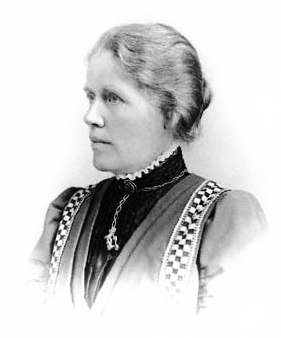Top Qs
Timeline
Chat
Perspective
Margaret Jane Benson
English botanist From Wikipedia, the free encyclopedia
Remove ads
Margaret Jane Benson (20 October 1859 – 20 June 1936) was an English botanist specialising in paleobotany, and one of the first female members of the Linnean Society of London.[1] Most of her career was spent as the head of the Department of Botany at Royal Holloway College, University of London from 1893 to 1922.[2] In 1927, a botanical laboratory was dedicated in her name.[2] She travelled extensively with Ethel Sargant, collecting specimens, laboratory equipment, and meeting other botanists around the world. Her students included Dame Helen Gwynne-Vaughan, Theodora Lisle Prankerd, Nesta Ferguson, and Emily Mary Berridge.[3][4]
Remove ads
Early life and education
Benson was born 20 October 1859 in London to William Benson and Edmunda Bourne, who was the daughter of the landscape painter James Bourne.[5] Benson's mother was also a painter and exhibited at the Royal Academy of Art.[6]
Benson was introduced to botany by her father, an engineer and architect with an interest in the subject.[5] She was first educated by her sister, who had attended Queen's College.[4] In 1878–9 she studied Classical Studies for one year at Newnham College, Cambridge, before working for seven years as a teacher at Exeter High School in order to have the finance for university study.[7][8] She then matriculated to University College London in 1887 and earned her bachelor's degree in Botany with first class honors from the university in 1891.[7][2] She gained a Marion Kennedy research scholarship[7] and earned her doctorate in 1894 from the University of London, working with Francis Wall Oliver.[5] Her work focused on embryology of a category of Fagales that were called Amentiferae at the time.
Remove ads
Work and achievements
Summarize
Perspective
Benson started working as a lecturer at Royal Holloway College in 1889.[7] Benson was appointed head of the Botany Department at Royal Holloway College in 1893,[5] and remained so until her retirement in 1922. She was the first female Botanist to become a department head in the UK.[2] In 1897, Benson travelled around Europe with Ethel Sargent to gain equipment and knowledge to set up the department.[9] Benson is also credited with planning and stocking the Botanical Garden, Herbarium and Museum.[5]
Benson made various collecting trips for botanical material, including to Australia in 1905–1906, and to Australia, Java and India in 1914-15.[5] Her observations of herbaceous plants from the early Paleozoic era and the earliest true ferns are considered notable.[5] She proposed a model for the evolution of the ovule,[10] which remains a likely explanation.[2] She also described the species Cordaites felicis found in coal deposits in England.[11] To adopt the new technique of microscopic anatomy of fossils, she cut sections herself with a gas-powered machine in her garden shed.[8] Her papers are characterised by precise drawings and wash-paintings which are believed to be produced by Benson herself.[2]
In 1904, she became a fellow of the Linnean Society of London,[1] one of the first fifteen women who were admitted.[5][12] In 1912 she was made a Professor by the University of London.[5]
Remove ads
Death and legacy
Upon her retirement in 1922,[5] Benson was succeeded by Professor Elizabeth Marianne Blackwell as Head of Botany at Royal Holloway College. Benson died in Highgate on 20 June 1936, and Blackwell authored Benson's official obituary.[4]
Publications
- M Benson (1893) Contributions to the Embryology of the Amentiferæ.—Part I. Transactions of the Linnean Society of London. 2nd Series: Botany 3(10):409-–424[13]
- M Benson (1902) A new Lycopodiaceous seed-like organ. The New Phytologist 1(3): 58-59[14]
- M Benson (1902) The fruitification of Lyginodendron oldhamium. Annals of Botany os-16(3): 575–576[15]
- M Benson (1904) Telangium Scotti, a new Species of Telangium (Calymmatotheca) showing structure. Annals of Botany 18(69): 161-177[10]
- M Benson, E Sanday, E Berridge (1906) III. Contributions to the Embryology of the Amentiferæ.—Part II. Carpinus Betulus. Transactions of the Linnean Society of London. 2nd Series: Botany 7(3):37–44[16]
- M Benson (1908) The Sporangiophore - A Unit of Structure in the Pteridophyta. The New Phytologist 7: 143-149[17]
- M Benson (1908) X. Miadesmia membranacea, Bertand; a new Palœozoic Lycopod with a seed-like structure. Philosophical Transactions of the Royal Society B 199 (251-261): 409-425[18]
- M Benson (1908) On the Contents of the Pollen Chamber of a Specimen of Lagenostoma ovoides. Biological Gazette 45(6): 409-412[19]
- M Benson and EJ Welsford (1909) The Morphology of the Ovule and female flower of Juglans regia and of a few allied genera. Annals of Botany 23(92):623-633[20]
- M Benson (1910) Root Parasitism in Exocarpus (with comparative Notes on the Haustoria of Thesium). Annals of Botany, os-24 (4): 667–677[21]
- M Benson (1911) New observations on Botryopteris antiqua, Kidston. Annals of Botany 25(100):1045-1057[22]
- M Benson (1912) Cordaites felicis, nov. sp., a Cordaitean leaf from the lower coal measures of England. Annals of Botany os-26(1):201-207[11]
- M Benson (1914) I.—Sphærostoma ovale (Conostoma ovale et intermedium, Williamson), a Lower Carboniferous Ovule from Pettycur, Fifeshire, Scotland. Earth and Environment Transactions of the Royal Society of Edinburgh 50(1): 1-17[23]
- M Benson (1918) Mazocarpon or the Structural Sigillariostrobus. Annals of Botany 32(128):569-589[24]
- M Benson (1921) The grouping of vascular plants. The New Phytologist 20(2): 82-89[25]
- M Benson (1922) Hetertheca Grievii the microsporange of Heterangium Grievii. Botanical Gazette 74(2): 121-142[26]
- M Benson and E Blackwell (1926) Observations on a lumbered area in Surrey from 1917 to 1925. Journal of Ecology 14(1):120-137[27]
- M Benson (1933) The Roots and Habit of Heterangium Grievii. Annals of Botany os-47(2): 313–315[28]
Remove ads
See also
References
External links
Wikiwand - on
Seamless Wikipedia browsing. On steroids.
Remove ads

